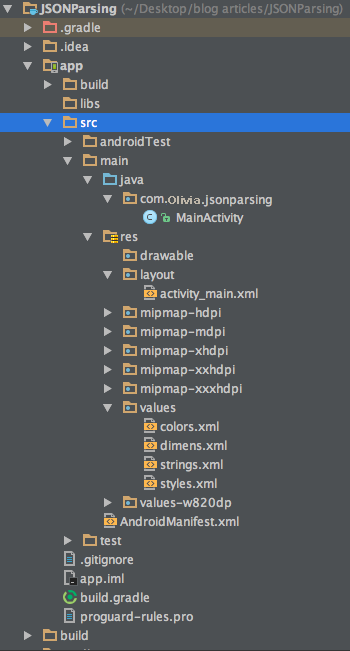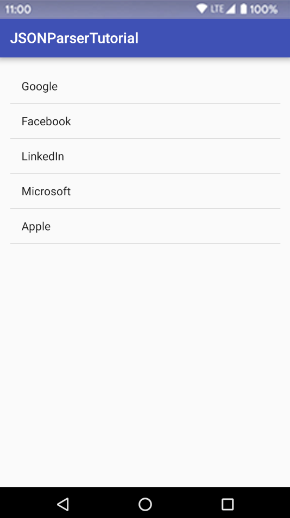AndroidのJSONObject – AndroidでのJSONパース
AndroidアプリでJSONパースにはAndroidのJSONObjectが使用されます。このチュートリアルでは、JSONデータをパースするためにAndroidアプリケーションにJSONObjectを実装し、その使用方法について説明します。JSONはJavaScriptオブジェクト表記法の略です。
JSONとは何ですか?
JSONは、サーバーとのデータのやり取り(投稿と取得)に使用されます。したがって、その構文と使いやすさを知ることが重要です。JSONはXMLの最良の代替手段であり、人間により読みやすくなっています。JSONは言語に依存しないため、任意の言語(Java/C/C++)でJSONをプログラムすることができます。サーバーからのJSONの応答は、多くのフィールドで構成されています。以下に、例となるJSONの応答/データを示します。これを参考にして、アプリケーションに実装します。
{
"title":"JSONParserTutorial",
"array":[
{
"company":"Google"
},
{
"company":"Facebook"
},
{
"company":"LinkedIn"
},
{
"company" : "Microsoft"
},
{
"company": "Apple"
}
],
"nested":{
"flag": true,
"random_number":1
}
}
このページからランダムなJSONデータ文字列を生成しました。JSONデータの編集に便利です。以下に4つの主要なコンポーネントがリストアップされているJSONデータです。
-
- 配列:JSON配列は角括弧([)で囲まれています。オブジェクトのセットを含んでいます。
-
- オブジェクト:中括弧({)で囲まれたデータは、単一のJSONObjectです。ネストされたJSONオブジェクトは可能で、非常によく使用されています。
-
- キー:すべてのJSONObjectは、特定の値を含むキー文字列を持っています。
- 値:各キーは、文字列、浮動小数点数、整数、ブール値など、任意のタイプの単一の値を持っています。
アンドロイドのJSONObject
上記の静的なJSONデータ文字列からJSONObjectを作成し、そのJSONArrayをListViewに表示します。JSONデータのタイトル文字列をアプリケーション名に変更します。
AndroidのJSON解析の例を示します。

アンドロイドJSONパースコード
以下にactivity_main.xmlが示されています。
<?xml version="1.0" encoding="utf-8"?>
<RelativeLayout xmlns:android="https://schemas.android.com/apk/res/android"
xmlns:tools="https://schemas.android.com/tools"
android:layout_width="match_parent"
android:layout_height="match_parent"
android:paddingBottom="@dimen/activity_vertical_margin"
android:paddingLeft="@dimen/activity_horizontal_margin"
android:paddingRight="@dimen/activity_horizontal_margin"
android:paddingTop="@dimen/activity_vertical_margin"
tools:context="com.scdev.jsonparsing.MainActivity">
<ListView
android:layout_width="wrap_content"
android:id="@+id/list_view"
android:layout_height="match_parent"/>
</RelativeLayout>
下記にMainActivity.javaが掲載されています。
package com.scdev.jsonparsing;
import android.support.v7.app.AppCompatActivity;
import android.os.Bundle;
import android.util.Log;
import android.widget.ArrayAdapter;
import android.widget.ListView;
import org.json.JSONArray;
import org.json.JSONException;
import org.json.JSONObject;
import java.util.ArrayList;
import java.util.List;
public class MainActivity extends AppCompatActivity {
String json_string = "{\n" +
" \"title\":\"JSONParserTutorial\",\n" +
" \"array\":[\n" +
" {\n" +
" \"company\":\"Google\"\n" +
" },\n" +
" {\n" +
" \"company\":\"Facebook\"\n" +
" },\n" +
" {\n" +
" \"company\":\"LinkedIn\"\n" +
" },\n" +
" {\n" +
" \"company\" : \"Microsoft\"\n" +
" },\n" +
" {\n" +
" \"company\": \"Apple\"\n" +
" }\n" +
" ],\n" +
" \"nested\":{\n" +
" \"flag\": true,\n" +
" \"random_number\":1\n" +
" }\n" +
"}";
@Override
protected void onCreate(Bundle savedInstanceState) {
super.onCreate(savedInstanceState);
setContentView(R.layout.activity_main);
try {
ListView listView = (ListView) findViewById(R.id.list_view);
List<String> items = new ArrayList<>();
JSONObject root = new JSONObject(json_string);
JSONArray array= root.getJSONArray("array");
this.setTitle(root.getString("title"));
for(int i=0;i<array.length();i++)
{
JSONObject object= array.getJSONObject(i);
items.add(object.getString("company"));
}
ArrayAdapter<String> adapter = new ArrayAdapter<String>(this,
android.R.layout.simple_list_item_1, items);
if (listView != null) {
listView.setAdapter(adapter);
}
JSONObject nested= root.getJSONObject("nested");
Log.d("TAG","flag value "+nested.getBoolean("flag"));
} catch (JSONException e) {
e.printStackTrace();
}
}
}
JSONArrayオブジェクトを繰り返し処理し、各子JSONObjectに存在する文字列を取得し、それらをArrayListに追加して、ListViewに表示しました。アプリケーション名は、次のように変更されます:
this.setTitle();
AndroidのJSONObjectの例の出力

AndroidのJSONパーシングJSONObjectプロジェクトをダウンロードします。
参照:公式ドキュメント

